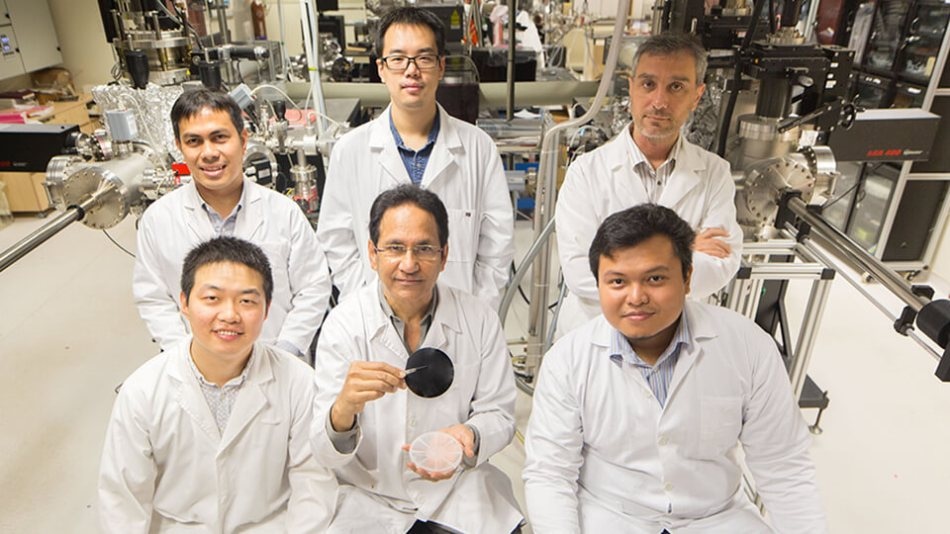May 16 2017
 Researchers led by Professor T Venky Venkatesan (first row, center), Director of NUSNNI, uncovered extraordinary properties of semiconductor material strontium niobate. Credit: National University of Singapore
Researchers led by Professor T Venky Venkatesan (first row, center), Director of NUSNNI, uncovered extraordinary properties of semiconductor material strontium niobate. Credit: National University of Singapore
Scientists at the National University of Singapore (NUS) have recently unearthed distinctive characteristics of strontium niobate. Strontium niobate is a peculiar semiconductor that exhibits photocatalytic activity as well as metallic type conduction.
The two researches were carried out in cooperation with scientists from the University of California, Berkeley, as well as the Lawrence Berkeley National Laboratory, and provide inspiring opportunities for the development of novel instruments with unparalleled functionalities and distinctive applications of a new class of photocatalytic materials.
The key to these successful studies was the ability of the NUSNNI team to produce high-quality crystalline films of these materials that were then studied by a variety of measurements to provide scientific clues on how such materials perform under varying conditions.
Dr Wan Dongyang, Scientist, NUS Nanoscience and Nanotechnology Institute (NUSNNI)
New family of plasmons uncovered in unconventional metal
In the first research, the research team headed by Assistant Professor Andrivo Rusydi and Director of NUSNNI Professor T Venky Venkatesan discovered that although strontium niobate is naturally highly metallic as a result of a huge number of electrons in it (a characteristic of majority of the metals), it is still transparent at much of the photon energies—an excellent characteristic different from most of the metals. The researchers employed spectroscopic methods and found out that this distinctive characteristic was due to an intrinsic plasmonic absorption.
Dr Teguh Citra Asmara, a postdoctoral researcher at NUSNNI as well as the first author of the paper stated, “From our studies, we found that this material is a semiconductor with a large bandgap of four electron volts. Based on our understanding of semiconductors and this material’s strong metallic behaviour, we did not expect this material to absorb any visible photons, so the results we found are indeed surprising.”
“Plasmons are resonant oscillations of a collection of electrons and typically occur in a metallic solid. Under the right conditions, photons can cause these plasmons to be excited in a solid and in this process the solid absorbs the photon energy. Before our team figured this out, this material was thought to consist of a smaller bandgap, of the order of two electron volts, and a secondary band above of comparable energy,” described Professor Venkatesan.
Moreover, the researchers discovered a new class of plasmons existing at multiple frequencies. The new class of plasmons was observed even though strontium niobate is not a traditional metal.
This novel discovery opens new research directions and paths for plasmonics research, and enables us to look into previously untapped insulating and strongly-correlated materials. We are also currently studying the possible applications of this new type of plasmons.
Assistant Professor Rusydi, National University of Singapore
The study was originally started by Dr Zhao Yongliang as part of his PhD thesis, and Dr Wan Dongyang joined the study as part of his doctoral thesis. Supervised by Professor Venkatesan, Zhao and Wan performed the research, and the innovative outcomes of the research were published in Nature Communications, a prestigious scientific journal, on 12 May 2017.
“Water splitters” to reduce carbon footprint
As part of the second research, NUS scientists investigated the manner in which strontium niobate catalyzes water. Under the supervision of Professor Venkatesan, the researchers discovered that when strontium niobate comes into contact with water in the presence of solar irradiation, it has the ability to split water into hydrogen and oxygen. The second research was also carried out in collaboration with scientists from the Nanyang Technological University, and was first published online on 19 April 2017 in Nature Communications.
While this material converts water into hydrogen under solar irradiation, the mechanism behind this process was previously misinterpreted as being due to the high speed or mobility of the electrons in the material. Our group clearly showed that it was not the case. The measured electron mobility was significantly low, but the effect was enhanced by the resonant absorption of the solar photons by the intrinsic plasmons present in this material.
Professor Venkatesan, National University of Singapore
The outcomes of the study firmly indicate an innovative technique for formulating catalysts for different applications, and the research can pave the way for innovative methods for extracting hydrogen (which is a sustainable fuel) from water, thus enabling reduction in carbon footprint.
“At NUSNNI, we have a group that has found a family of materials, aside from strontium niobate, that work equally well as plasmonic water splitters. Moving forward, we are working towards finding the right combination of photo-catalytic process for producing useful chemicals,” further stated Professor Venkatesan.